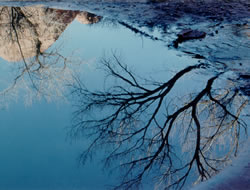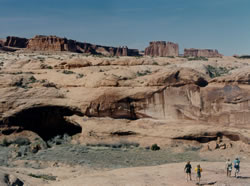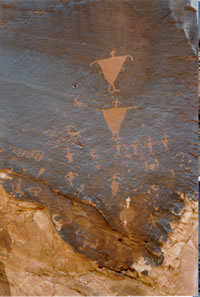|
Hiking
Happenings April 2004
Walkabout with
Rory Tyler
Dear April,

Reflection
in Courthouse Wash
|
I’m sorry if I sound like
a sap. I know I’m not the only guy in love with you,
but I still have to tell you that I think you are the most
beautiful, vibrant, captivating month of the year. Everyone
morning when I wake in your presence my heart sings your praises
and its gratitude. I’m enchanted by your lush, languid
character and excited by your temperamental moments. I’m
grateful for the generous gifts you bestow and how forgiving
you can be. The other months are sometimes harsh and cruel.
You, my dear April, are the kindest of them all.
I’m unabashedly fascinated by the way you drape yourself
in diaphanous folds of fresh blossoms, soaring birds, scampering
lizards, and all the busy bugs and bees. If I live to be a
thousand I know you will still be able to overwhelm me with
a heady, honey-scented cloud of cliff rose perfume purling
along on a canyon trail or with an emerald-backed hummingbird
sipping nectar at a scarlet penstemmon. And then, when I’m
stunned by your intensity, you express such delicacy and sensitivity
that I am compelled to stop and contemplate the near-infinity
of indescribable nuance you bring to the simplest moment.
For a mere mortal, trying to see and comprehend all that you
are is an impossible challenge; one I will always accept with
joy.
It’s been a whole year now and I so look forward to
taking comfort in your company. Though memories of you nourish
my heart and soul every time I pause to savor them, memory
cannot compare to the elation I will feel when you embrace
me once again. Back in your gracious presence, you will shower
me with an embarrassment of treasures and privileges. There’s
no way I can ever repay you for what you have already given,
yet you will give me more and more. Beloved April, you are
the most precious month of the year and I adore you.
Love,
Rory

Hiking in Courthouse
Wash |
Courthouse Wash
As my little love note indicates, April is the month when
the desert comes alive. You’ll want your guidebooks,
binoculars, and maybe even a magnifying glass to become intimately
involved with the abounding life. Springtime comes first to
the lower canyons and always makes an early appearance in
the accessible and convenient Courthouse Wash. The trailhead
is on Highway 191, a quarter mile north of the river bridge.
Dog owners, motorcyclists, and marksmen be advised; Courthouse
Wash is inside Arches National Park and Fido, Suzuki, and
Remington are not welcome here.
The bottom of the wash is wide, level, and sandy. In April
water usually flows, so this is a great place to walk in your
shorts, tennies, and sandals. There’s a little shallow
quicksand here and there, which is not dangerous but can be
a bit spooky at first. Later, the kids might wind up playing
in it. The sides of the canyon are mostly long sandstone walls
that extend for miles. You might spot a raven or red-tailed
hawk nest, either in the cliffs and crannies of the main canyon
or in one of the side canyons that take off to the right.
These side canyons are fun to explore, but present primarily
dead ends to all but the most skilled and intrepid hikers.
Fair warning! It’s always easier to climb up than it
is to come down. Proceed at your own risk.
| 
2000 year old Indian art in
Right Hand Canyon 0f Mill Creek
|
The Right Hand of Mill Creek
One of the reasons I suggest bringing a magnifying glass is
for bug watching. (Binoculars are good for lizards!) There
are bees, beetles, wasps, flies, ants, spiders and a billion
other bugs running around in April doing all kinds of unimaginable
and enigmatic things. Bugs are really fun. Want to have a
good time? Find a gorgeous purple-and-periwinkle colored fishhook
barrel cactus blossom and settle in next to it. Peer closely
into the forest of golden stamens and start looking for all
the different critters crawling around in this glimmering
glade of pollen-laden pillars, losing yourself for a while
in the symbiotic light and motion of a living flower.
Mill Creek is a wonderful place to find that fishhook barrel
blossom…or a claret cup, a penstemmon, a cliff rose,
an alium, an ansonia, and so on. It also contains a treasury
of ancient Indian rock art, which if you come across it deserves
your utmost respect. Never ever write or mark on or near piece
of rock art. Keep an especially close eye on the kids. Once
they see something on the wall they have an innocent and natural
inclination to make their own marks. Uh-uh!
Mill Creek has two branches, the
North and South, or as the locals call them, Left Hand and
Right Hand. It is a wilderness study area so you can take
Fido anywhere, but have to keep Suzuki on the Steelbender
Trail. A good place to access the Right Hand is above the
golf course. Drive south of town about three miles and take
a left at the Shell Station onto Golf Course Road. Go a mile
to a traffic circle and merge onto Westwater Drive. Follow
it another a mile to the top of the hill where it meets the
Steelbender Trail. From there the walk is easy and pleasant.
There’s lots of water in the bottom so be prepared for
a stream crossing or two.
|
Cryptos
(krip’ tose): The surface of Moab’s
desert is held together by a thin skin of living organisms
known as cryptobiotic soil or cryptos. It has a lumpy
black appearance, is very fragile, and takes decades
to heal when it has been damaged. This soil is a critical
part of the survival of the desert. The cryptobiotic
organisms help to stabilize the soil, hold moisture,
and provide protection for germination of the seeds
of other plants.
Without it the dry areas of the west
would be much different. Although some disturbance is
normal and helps the soil to capture moisture, excessive
disturbance by hooves, bicycle tires and hiking boots
has been shown to destroy the cryptobiotic organisms
and their contribution to the soil. When you walk around
Moab avoid crushing the cryptos. Stay on trails, walk
in washes, hop from stone to stone.
Whatever it takes, don’t
crunch the cryptos unless you absolutely have
to! |
Day Canyon
Day Canyon is completely different from the other two canyons
I’ve discussed. It is a narrow, rocky chasm rimmed by
perpendicular precipices and soaring columns and towers of
Wingate Sandstone. While Day Canyon shares the seasonal charms
of April, it is physically more austere and visually more
spectacular than the other two. What it loses in the warm-fuzzies
it makes up for in grandeur and stature. When you walk up
Day Canyon you’ll feel like one of those miniscule brown
beetles crawling around in the bottom of a cactus blossom.
It’s simultaneously humbling and inspirational.
To get to Day Canyon go a mile north of the Colorado River
bridge to the Potash Road, then 11.5 miles on the Potash Road
to the mouth of the canyon. The canyon is deep, narrow defile
on the right and the trailhead has a wire-mesh gate and broken-down
fence across its mouth. Four-wheelers used to drive here but
the canyon has been closed to them for a few years now. Now,
the trail is cleared mostly by rock climbers. The first two
hundred yards of trail wend through a tamarisk grove, then
turns left. Shortly after this point you have a choice of
staying in the canyon bottom and wending through the tammies
and cottonwoods through a stretch sentimentally reminiscent
of the enchanting Fanghorn Forest, or you can cross the wash
and climb onto a rocky shoulder on the right. The latter option
requires a few scrambling moves, but is somewhat lighter and
sunnier. Both trails rejoin in less than a mile, climbing
up the canyon along the abandoned four-wheel drive road. There
is an old cattle trail at the head of the canyon that allows
you to climb out if you so desire. Round trip is between seven
and eight miles. Keep your eyes peeled for petrified wood.
There are entire logs of it exposed in the Chinle formation
just below the Wingate.
Rory Tyler
leads custom rock art tours and backcountry hikes for people
of all skill levels for Canyon Voyages Adventure Company.
|


